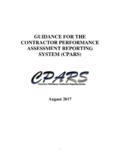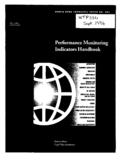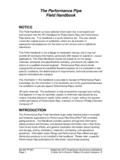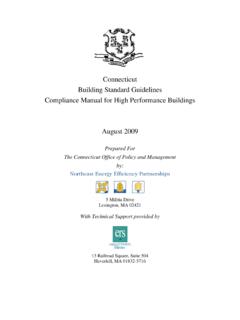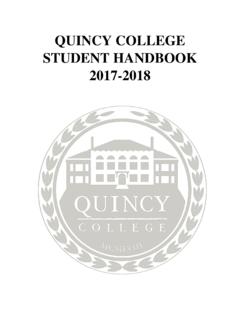Transcription of BY ORDER OF THE AIR FORCE HANDBOOK 63-1402 …
1 BY ORDER OF THESECRETARY OF THE AIR FORCE AIR FORCE HANDBOOK 63-140219 MARCH 2001 AIR MOBILITY COMMANDS upplement21 APRIL 2008 AcquisitionAIRCRAFT information PROGRAMACCESSIBILITY: Publications and forms are available for downloading or ordering on the e-Pub-lishing website at RELEASABILITY: There are no releasability restrictions on this publication. OPR: HQ AFSC/SEF Certified by: AF/SE (Maj. Gen. Timothy A. Peppe)Pages: 59(AMC) OPR: HQ AMC/SEF Certified by: HQ AMC/SE(Colonel David R. Miller)Pages: 2 This HANDBOOK assists in the establishment of Aircraft information Programs and provides guidance inselecting recording parameters and functional requirements for information collection systems.
2 (AMC) AFH 63-1402 , dated 19 March 2001 is supplemented as follows: provides guidance for the acqui-sition of a standard 2-hour digital Cockpit Voice Recorder (CVR) for all aircraft for which Air MobilityCommand (AMC) is lead command. This product does not replace or override current or future regula-tions. This instruction applies only to AMC-owned assets and personnel. Ensure that all records created asa result of processes prescribed in this publication are maintained in accordance with AFMAN 33-363,Management of Records, and disposed of in accordance with the Air FORCE Records Disposition Schedule(RDS) located at Refer recommended changes and questions about this pub-lication to the Office of Primary Responsibility (OPR) using the AF IMT 847, Recommendation forChange of Publication; route AF IMT 847s from the field through the appropriate functional chain ofcommand.
3 Goals .. Formation.. information Management Plan .. Selection Process..6 Certified Current on 6 April 20152 AFH63-1402_AMCSUP_I 21 APRIL 2008 Table Wing Aircraft Parameters.. 8 Table Wing Aircraft Parameters.. 35 Attachment 1 GLOSSARY OF REFERENCES AND SUPPORTING information 58 Attachment 1 (AMC) GLOSSARY OF REFERENCES AND SUPPORTING information 59 AFH63-1402_AMCSUP_I 21 APRIL 200831. Introduction The Aircraft information Program (AIP) supports mishap investigations, Flight OperationalQuality Assurance (FOQA), Reliability Centered Maintenance (RCM), Aircraft and Engine StructuralIntegrity Programs (ASIP/ENSIP), aircraft development programs and training.
4 Its primary goal is tobalance information needs with program resources and operational considerations. This handbookprovides guidance in selecting the appropriate recording parameters and functional requirements forinformation collection systems. Mishap investigations are relatively straightforward processes where causes and contributingfactors are determined and used to produce a list of recommendations that should prevent future mis-haps. However, many investigations are inconclusive due to lack of evidence to support mishap sce-narios. This allows insidious conditions to persist and cause future mishaps. 2. Program Goals Institutionalize Mishap Investigative information Requirements Voice and data recorders for mishap information collection have traditionally lacked advo-cates in the operational and acquisition communities.
5 Standing policy requiring Flight Data Recorders (FDRs) was issued in 1973. LessonsLearned since that time have illustrated the need to institutionalize a process requiring the explicitaddressing of investigative information data gathering needs. Numerous customers exist for recorded aircraft information . Training and mishap investi-gation are two obvious reasons to record the performance of the aircraft and crew. Industry haspioneered the use of such information in a proactive mode. A FOQA program examines non-mis-hap flight data in a non-attribution basis to identify hazardous flight procedures and environments. The engine and structural communities have been performing RCM for many years.
6 Theutility of predicting component wearout or imminent failure has resulted in extensive cost ability to remove or repair on an as needed basis versus scheduled intervals has saved costsand circumvented component failures leading to mishaps. Improve Quality of Mishap Investigation and Reporting The Air FORCE forms boards to investigate and determine the cause(s) of mishaps. Whilemany mishaps are straightforward and benefit from surviving crew testimony, the majorityrequires extensive analysis, test and simulation. With modern aircraft employing electronic con-trol systems and video displays, some physical evidence no longer exists at the mishap scene.
7 Those aircraft with crash survivable data recorders have demonstrated more conclusiveinvestigations than those without recorders. This allows the board to spend less time determiningwhat occurred and more time determining why a mishap occurred. Enable FOQA and RCM Programs Commercial aviation has pioneered the use of non-mishap data to detect hazardous oper-ational trends. Examples of such trends would include excessive bank angles, hard landings, andunstabilized approaches. In general, looking for any trigger that would focus attention on a haz-ardous situation. 4 AFH63-1402_AMCSUP_I 21 APRIL The implementation of a FOQA program presents a number of challenges.
8 One hotlydebated topic is the potential use of FOQA data for punitive action. The identity of the crew mustbe stripped from the data within a short time span and at the lowest organizational level , pre-processing of the data must be accomplished in a timely manner to allow inter-viewing the crew for clarification of unique data trends. Flight crew acceptance of FOQA as anon-punitive program is a fundamental building block that cannot be compromised. Another FOQA challenge is the sheer volume of collected information . Ground supportsoftware requires specific triggers to analyze the recorded data and detect hazardous suspect records then require closer human evaluation to validate the concern of the expertsystem.
9 Commercial aviation includes equipment monitoring and trending in its definition ofFOQA while the Air FORCE refers to it as Reliability Centered-Maintenance (RCM). In any event,it has been shown in both government and industry that impressive cost savings can be accom-plished. Whether it s extending the removal interval of engines, or detecting excessive fuel con-sumption due to flight control misrigging, both safety and cost avoidance are accomplished. Assure Integrated Solution There are many sources of information on an aircraft. Modern aircraft systems have digitaldatabuses with volumes of parametric data readily available for recorders.
10 Cockpit Voice Record-ers are on many aircraft capturing valuable acoustic information . Training needs often result inHeads-Up-Display (HUD) and Multi-Function Display (MFD) video recorders. Future weapon systems may have separate acoustic, video and parametric informationsources or achieve optimizations through integration of the technologies. Analyzing the total sys-tem requirements will provide the best and lowest cost solution to the program. Enhance Training Effectiveness Videotapes of Heads-Up-Display (HUD) and Multi-Function Display (MFD) images arecurrently used in crew training. The tapes occasionally survive crash dynamics and contribute toboard investigations.










